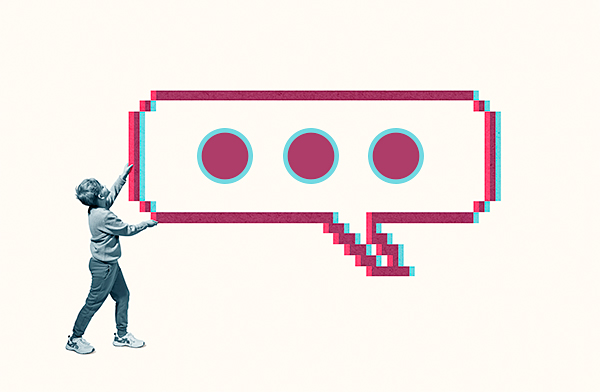It’s 10 a.m. on a Tuesday, and the 20 newcomers to Canada in the brightly lit conference room look expectantly at me as I roll to the front in Scarlett O’Chaira, my power wheelchair.
For the next few hours, we’ll work on their conversational English skills — telling stories and sharing feelings, tackling pronunciation, exploring the nuances of the language and how the slightest changes in tone or sound alter a word’s entire meaning.
I’ll lead this group, despite not a word crossing my lips.
Instead, I’ll type into an AAC (augmentative and alternative communication) device, which will speak my words in an electronic voice. As my late grandmother would say, I can talk the ear off a cat. I love to communicate — and AAC allows me to, despite a long-standing medical condition that drastically limits my verbal ability.
When I began volunteering with Catholic Social Services in 2019, I wondered if it was even possible for an AAC communicator to help others acquire spoken English. I aspire to live with vibrancy, however, so I decided to try. Life has taught me that with a little creativity and a whole lot of never-giving-up, beautiful things are born.
And that’s what happened. Despite its somewhat robotic sound, my AAC voice is smooth and clear, the perfect communication method with people new to English.
While it’s true the voice is woefully devoid of the richness and vastness of human emotion and tone, I compensate through heightened facial expressions, enhanced body language, the glint in my eyes and a left eyebrow I can strategically arch at whim.
Being an AAC communicator has built a bridge of understanding with the newcomers I volunteer to teach. Many have shared their struggles to communicate in stores, offices and their children’s schools. They’ve told me how stressful it is to try extremely hard but still not be understood. To sometimes be treated with contempt.
While I don’t pretend to know what it’s like to be a newcomer, I understand what it’s like to experience misunderstanding and judgment.
Some people get nervous around me, giggling uncontrollably. Others talk in a slow, high-pitched voice like I’m a toddler. When I order a burger at a restaurant, it’s not uncommon for the server to ask my husband if I want fries. These situations hurt, but they inspire me to be more intentional about the kindness I offer others.
I’ve learned that people intuitively sense how much you care, which positively affects the quality of your communication and connection. Empathy is the heart of communication. Forging a connection is far more important than how you communicate.
But it’s not easy to communicate through AAC. Nearly every first meeting with someone begins awkwardly, be it with my child’s teacher, a cashier, new neighbours or another person at a meeting. Usually, an involuntary startled expression crosses their face; I see them mentally recategorize me as different. I still haven’t figured out how to stop the shame this triggers.
But what I find heartening is how, with the vast majority of people, the initial awkwardness quickly transforms into genuine warmth. Within seconds, we dive into robust conversation.
Sometimes, though, fear bests me.
For example, my husband and I adopted four kids who range in age. The older two are young adults now, and when I first met their doctors, prior caregivers, social workers and teachers, I worried that they’d register my differences as parental incompetence.
Going through the adoption approval process with Children’s Services is intense at the best of times, but it’s a whole different ball game as a non-verbal applicant. To my relief, my disability was not treated as a deterrent.
When my kids arrived, they didn’t see my disabilities as a big deal. To them, I’m just their mom who adores them, cooks supper, nags them to do homework and offers hugs and love aplenty. Instead, it’s society that is often stunned to see a mom with differences.
Wherever I go, I’m cognizant of the increased pressure to present well in a way verbal communicators don’t face, whether at church, meeting the parents of my kids’ friends or making small talk at a party. I live with the knowledge I’ll be judged differently; there is less room for mistakes in a world where disability is often seen as a detriment.
But, as with all things in life, I’ve learned to take it in stride, allowing the pain to build empathy, reminding me that a vibrant life is not built on my method of communication but on kindness, creativity, contribution and joy.

We at New Trail welcome your comments. Robust debate and criticism are encouraged, provided it is respectful. We reserve the right to reject comments, images or links that attack ethnicity, nationality, religion, gender or sexual orientation; that include offensive language, threats, spam; are fraudulent or defamatory; infringe on copyright or trademarks; and that just generally aren’t very nice. Discussion is monitored and violation of these guidelines will result in comments being disabled.